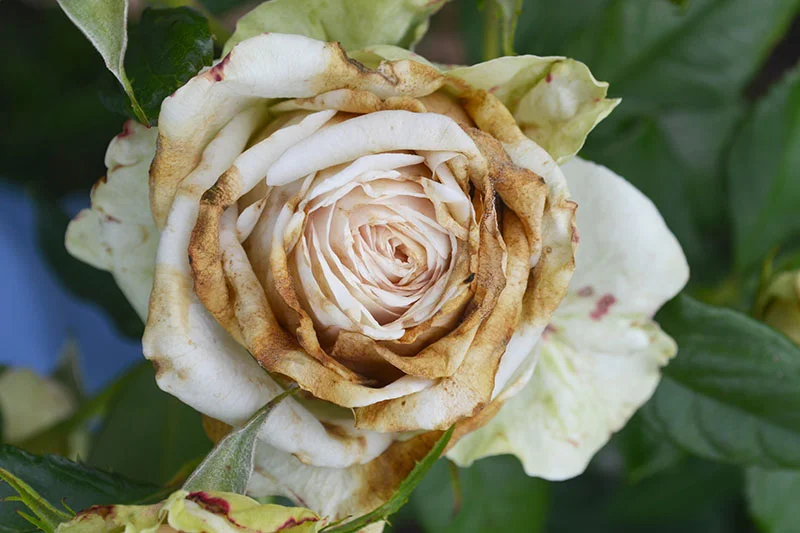Why Do My Rose Petals Have Brown Edges

If you notice brown edges on the petals of your roses, it’s important to take action quickly. There are a few possible causes of this problem, so it’s important to diagnose the issue correctly. Once you know what’s causing the brown edges, you can take steps to fix the problem and prevent it from happening again in the future.
If you’ve noticed that your rose petals have brown edges, it’s likely due to one of two things: either the petals are old and starting to decompose, or they’ve been damaged by a herbivore. In either case, there’s not much you can do about it. If the petals are old, you can simply remove them from the plant.
If they’ve been eaten, you may need to take steps to protect your plant from further damage.
Why Does a Rose Petal Edge Turn Brown?
Why Do My Rose Petals Have Brown Edges
If you’ve noticed that your rose petals have started to develop brown edges, there are a few possible explanations. First, it could be a sign of dehydration. Roses need a lot of water, so make sure you’re watering them regularly and deeply.
Second, the brown edges could be caused by a fungal disease called botrytis. If you think this might be the case, take a look at the rest of the plant for signs of infection, such as fuzzy gray mold on the leaves or stems. If you see any other symptoms, it’s best to remove infected parts of the plant to prevent the disease from spreading.
Finally, brown edges can also be caused by too much sun exposure. If your roses are in a sunny spot, try moving them to an area with more shade. By taking these steps, you should be able to get your roses back to looking their best in no time!
Is It Normal for Rose Petals to Have Brown Edges
It’s perfectly normal for rose petals to have brown edges. In fact, it’s a sign that your roses are healthy and happy! The brown edges on rose petals are caused by a process called respiration.
During respiration, plants release energy from the food they’ve taken in (in the form of sugar). This process happens more quickly in warm weather, which is why you might notice that your roses’ petals seem to be browning more during summer months. Don’t worry – this is totally natural and there’s no need to do anything about it.
Just enjoy your beautiful blooms!
What Causes Rose Petals to Have Brown Edges
When you see rose petals with brown edges, it’s usually an indication that the flower is past its prime and starting to wilt. There are several reasons why this happens, but the most common one is simply age. As roses age, their petals begin to dry out and lose moisture, causing them to become brown and brittle.
Another reason for brown-edged petals can be exposure to too much sun or heat. When roses get too much sunlight, their pigments start to fade and the edges of the petals can become bleached or burnt. Too much heat can also cause wilting and Browning of the petals.
Lastly, insufficient watering can also lead to Browning of rose petals. If your plants are not getting enough water, they will start to wilt and the edges of the leaves and petals will turn brown as a result.
Are Brown Edges on Rose Petals a Sign of Overall Browning?
Brown edges on rose petals can be an indication of overall browning. To tackle this issue, finding the right rose petal discoloration solution is crucial. By implementing effective remedies and providing the necessary care, you can help maintain the vibrant beauty of your roses and prevent unsightly brown edges from appearing.
How Can I Prevent My Rose Petals from Having Brown Edges
If you notice your rose petals beginning to brown at the edges, there are a few things you can do to prevent this from happening. First, make sure that you are watering your roses regularly and evenly. Roses need about 1-2 inches of water per week, so be sure to check the soil before watering to see if it is dry.
It is also important to fertilize your roses regularly with a good quality fertilizer. This will help them stay healthy and strong, which will in turn help prevent browning of the petals. Finally, make sure that you are deadheading your roses regularly.
Deadheading means removing spent blooms from the plant. This helps encourage new growth and keeps the plant looking its best. If you follow these steps, you should be able to prevent your rose petals from browning at the edges.

Credit: www.gardeningknowhow.com
Conclusion
If you notice your rose petals have brown edges, it’s likely due to one of three things: wind damage, sun damage, or lack of water. Wind damage is most common in spring when the weather is still changing and can cause the petals to dry out and turn brown. Sun damage usually happens during summer when the temperatures are high and the sun is intense.
This can cause the edges of the petals to scorch and turn brown. Lack of water can happen any time of year but is most common during periods of drought. When the soil doesn’t have enough moisture, it causes the plant to stress which can lead to browning petals.
If you think your roses have any of these issues, take a closer look and see if there are other signs like wilting leaves or stems that are discolored. Correcting the problem early on will help ensure a healthy plant for seasons to come.
